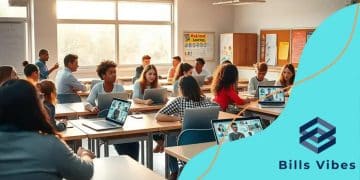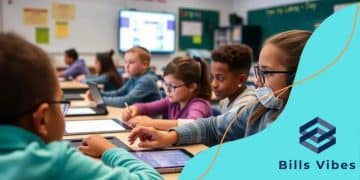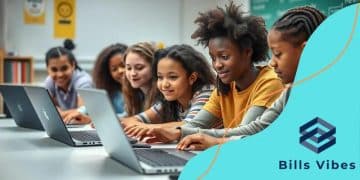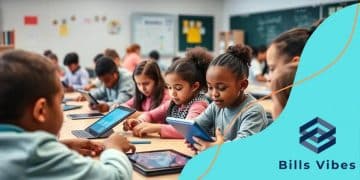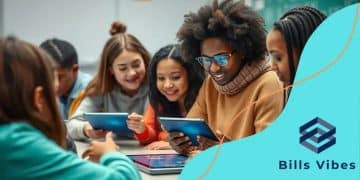Personalized learning platforms: revolutionizing education
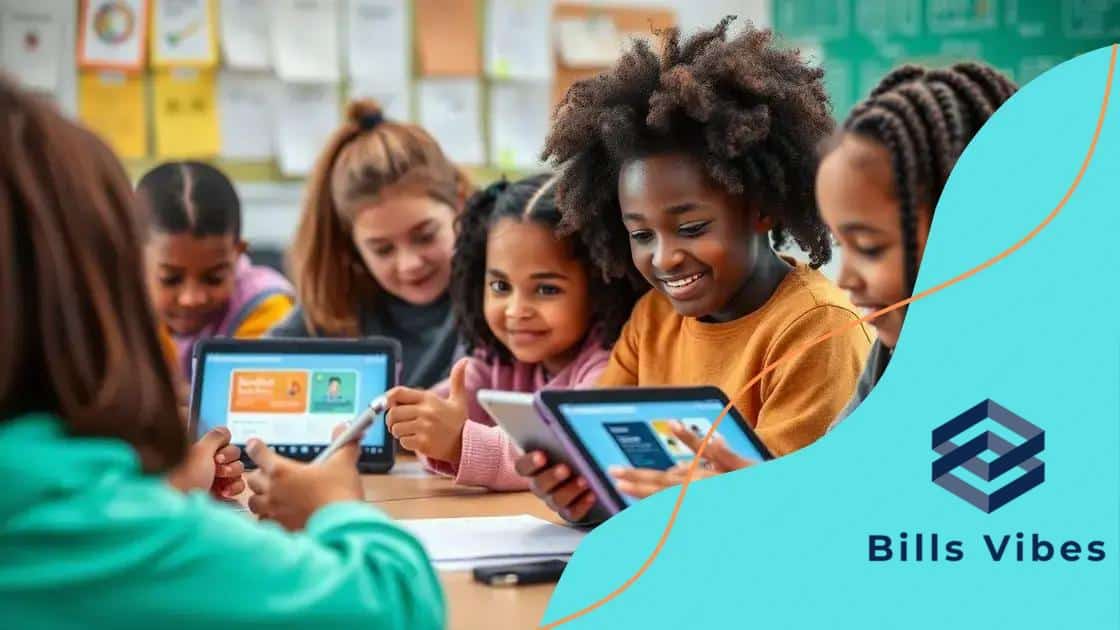
Personalized learning platforms tailor educational experiences to individual students, utilizing technology like AI and data analytics to improve engagement and learning outcomes.
Personalized learning platforms are changing the way we approach education. Imagine an environment where learning is tailored specifically to you, addressing your unique strengths and challenges. Isn’t that a game changer?
What are personalized learning platforms?
Personalized learning platforms are innovative educational tools designed to cater to the unique needs of each learner. These platforms adapt content and teaching methods based on individual performance and preferences, creating a tailored learning experience.
These platforms utilize technology to analyze student data and deliver customized resources, ensuring learners receive the appropriate challenges and support. This tailored approach helps students engage more deeply and perform better.
Key Features of Personalized Learning Platforms
Some essential features that define personalized learning platforms include the following:
- Adaptive learning paths that evolve based on student progress.
- Real-time feedback to help learners understand their strengths and areas for improvement.
- Varied content formats, such as videos, quizzes, and interactive activities.
- Data tracking to provide insights into student performance and engagement.
Teachers often find these platforms valuable, as they allow for greater focus on individual student needs. By integrating various learning methods, such as gamification and social learning, these platforms create an engaging environment that motivates students.
Moreover, the accessibility of personalized learning platforms enables students to learn at their own pace. This flexibility is particularly advantageous for learners with different needs, as it accommodates various learning styles.
Benefits for Students and Educators
The advantages of personalized learning extend to both students and educators. For students, these platforms can boost confidence and independence by promoting self-directed learning. Educators also benefit from the ability to monitor students more effectively, leading to better educational outcomes.
Another important aspect of personalized learning is collaboration. Many platforms encourage interaction among learners, fostering a sense of community and motivating students to support each other.
Ultimately, personalized learning platforms represent a significant shift in educational technology. By prioritizing the learner’s experience, they prepare students for a dynamic and diverse world.
Benefits of personalized learning for students
Understanding the benefits of personalized learning for students can truly change their educational experience. These platforms provide a unique approach that caters to each learner’s needs, allowing them to thrive in a supportive environment.
One major benefit is increased engagement. When students interact with materials that relate to their interests, they are more likely to be motivated. This active participation can lead to better retention of information.
Individualized Learning Experiences
Personalized learning promotes individualized experiences that can be tailored to specific learning styles. This adaptability means that visual learners can benefit from videos, while others may prefer reading texts.
- Accommodating different learning speeds.
- Offering multiple resources for concepts.
- Allowing students to choose their learning paths.
This variety helps maintain student interest and prevents frustration. Personalized learning helps to bridge gaps in understanding by providing targeted resources based on assessments.
Another important aspect is the development of critical thinking skills. As students navigate personalized pathways, they are often required to solve problems and make decisions. This process cultivates their ability to think critically and independently.
Enhancing Confidence and Ownership
Moreover, students report a boost in confidence when they can progress at their own pace. They feel a sense of ownership over their learning, which leads to a positive attitude toward education. With personalized support, they can set achievable goals and celebrate their milestones.
Personalized learning also encourages collaboration among peers. Many platforms feature group activities that allow students to learn from one another, fostering community and teamwork.
Overall, implementing personalized learning strategies not only addresses academic needs but also nurtures social and emotional growth.
How to choose the right platform

Choosing the right platform for personalized learning is crucial for enhancing students’ educational experiences. With so many options available, it’s important to assess specific features that can cater to individual needs.
One of the first steps in selecting a platform is to determine your goals. Ask yourself what you want to achieve with personalized learning. Are you looking to improve engagement, offer customized content, or enhance student performance?
Key Considerations for Platform Selection
When evaluating various platforms, keep the following factors in mind:
- Usability: Is the platform easy for both students and teachers to navigate?
- Customization: Can the platform adapt to different learning styles?
- Integration: Does it work well with existing tools and systems?
- Support: What kind of technical assistance is provided?
It’s also beneficial to look for platforms that offer a rich variety of learning materials. The more options available, the better you can address diverse student needs. Ensure that resources like quizzes, videos, and interactive games are included, as they engage learners effectively.
Testing out a platform through a trial period can provide valuable insights. This allows you to see its effectiveness in real classroom scenarios. Gather feedback from both students and teachers during this time to make an informed decision.
Community and Resources
Additionally, consider the community around the platform. A strong user community can provide support and share best practices. Look for platforms that have active forums and additional resources for continuous learning, as these can enhance your experience.
In conclusion, the right personalized learning platform can make a significant difference in educational success. By carefully evaluating options based on your specific goals and the features mentioned, you can select a platform that truly meets the needs of your students.
Challenges in implementing personalized learning
Implementing personalized learning can bring many benefits, but it also presents several challenges. Understanding these challenges is essential for creating a successful personalized learning environment.
One significant hurdle is the varied levels of technology proficiency among both students and teachers. Some learners may struggle to use new platforms effectively, affecting their ability to engage with personalized content. This issue can create a gap in learning opportunities.
Resource Availability
Another challenge stems from the availability of resources. Not all schools have access to the necessary technology and tools to implement personalized learning successfully. Schools with limited budgets may find it hard to acquire suitable software or hardware, restricting their ability to provide individualized experiences.
- Limited access to high-speed internet.
- Inadequate training for educators on new systems.
- Shortage of learning materials tailored for personalization.
Furthermore, there can be resistance from educators who favor traditional teaching methods. Some educators may feel overwhelmed by the shift to tech-driven instruction or may question the effectiveness of these platforms.
Data Management and Privacy Concerns
Data management is another critical issue. Collecting and analyzing data on student performance can help tailor learning experiences, but it also raises concerns about privacy. Safeguarding student information while making it accessible to educators is a delicate balance that must be maintained.
The customization process may also take time and patience. It requires ongoing assessments and adjustments to ensure that each learner’s needs are met adequately. Educators must be committed to consistently refining their approaches and embracing flexibility.
Despite these challenges, many educators understand the importance of personalized learning and are committed to overcoming obstacles. By continuing to address these issues head-on, schools can create environments that foster meaningful progress for all students.
Future trends in personalized education
The future of personalized education is bright and full of possibilities. As technology continues to advance, personalized learning platforms will evolve, offering even more tailored experiences for students.
One clear trend is the increased use of artificial intelligence (AI) in educational settings. AI can analyze vast amounts of student data to provide real-time feedback and suggestions. This capability helps educators create customized learning paths that adapt to each student’s progress and needs.
Integration of Virtual and Augmented Reality
An exciting development is the incorporation of virtual and augmented reality (VR and AR) into personalized learning. These technologies can immerse students in engaging environments, making learning more interactive. For example, history lessons can come to life with VR simulations, allowing students to experience events firsthand.
- Enhanced engagement through immersive experiences.
- Opportunities for hands-on learning in safe environments.
- Visualizing complex concepts in science and mathematics.
Another trend is the emphasis on social-emotional learning (SEL). Future personalized platforms will integrate SEL components, which focus on developing students’ emotional intelligence and interpersonal skills. This important addition can help students navigate their educational journeys while also fostering resilience and empathy.
Data-Driven Insights for Instruction
As data analytics continues to grow, teachers can expect deeper insights into student performance. Enhanced analytics tools will enable educators to make informed decisions about curriculum adjustments and individual support. By reviewing trends in learning data, teachers can identify areas where students struggle and intervene more effectively.
Moreover, collaboration among educators will become more common. Sharing best practices and resources across platforms can lead to improved strategies for personalized education. As schools work together, they can refine their approaches and provide students with richer learning experiences.
In summary, the future of personalized education holds vast potential. With emerging technologies and a focus on individual student needs, learning can become more engaging, supportive, and effective for everyone.
In conclusion, personalized learning platforms offer exciting opportunities for educational success. By adapting to each student’s needs, these platforms can improve engagement and promote better learning outcomes. The future trends in personalized education—like the integration of AI, VR, and social-emotional learning—indicate a shift towards a more individualized and supportive approach. While challenges such as technology access and teacher training exist, the benefits far outweigh the obstacles. With continued dedication to this innovative method, we can create enriching environments that empower all learners. 🌟
FAQ – Frequently Asked Questions about Personalized Learning Platforms
What are personalized learning platforms?
Personalized learning platforms are educational tools that adapt content and teaching methods to meet the individual needs of each student, enhancing their learning experience.
How does artificial intelligence improve personalized learning?
Artificial intelligence analyzes student data to provide real-time feedback, enabling educators to create customized learning paths that cater to each student’s progress.
What challenges might schools face when implementing personalized learning?
Schools may encounter challenges such as varying levels of technology proficiency among students and teachers, limited resources, and privacy concerns regarding student data.
What future trends can we expect in personalized education?
Future trends include increased use of virtual and augmented reality for immersive learning experiences, and a greater emphasis on social-emotional learning to support student well-being.


